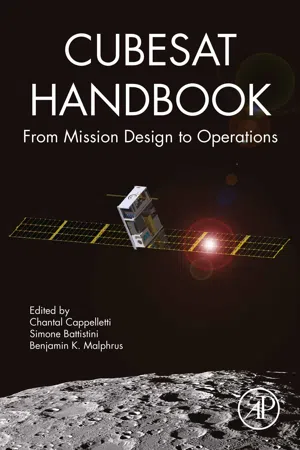
CubeSat Handbook
From Mission Design to Operations
- 498 pages
- English
- ePUB (mobile friendly)
- Available on iOS & Android
CubeSat Handbook
From Mission Design to Operations
About this book
CubeSat Handbook: From Mission Design to Operations is the first book solely devoted to the design, manufacturing, and in-orbit operations of CubeSats. Beginning with an historical overview from CubeSat co-inventors Robert Twiggs and Jordi Puig-Suari, the book is divided into 6 parts with contributions from international experts in the area of small satellites and CubeSats. It covers topics such as standard interfaces, on-board & ground software, industry standards in terms of control algorithms and sub-systems, systems engineering, standards for AITV (assembly, integration, testing and validation) activities, and launch regulations.This comprehensive resource provides all the information needed for engineers and developers in industry and academia to successfully design and launch a CubeSat mission.- Provides an overview on all aspects that a CubeSat developer needs to analyze during mission design and its realization- Features practical examples on how to design and deal with possible issues during a CubeSat mission- Covers new developments and technologies, including ThinSats and PocketQubeSats
Frequently asked questions
- Essential is ideal for learners and professionals who enjoy exploring a wide range of subjects. Access the Essential Library with 800,000+ trusted titles and best-sellers across business, personal growth, and the humanities. Includes unlimited reading time and Standard Read Aloud voice.
- Complete: Perfect for advanced learners and researchers needing full, unrestricted access. Unlock 1.4M+ books across hundreds of subjects, including academic and specialized titles. The Complete Plan also includes advanced features like Premium Read Aloud and Research Assistant.
Please note we cannot support devices running on iOS 13 and Android 7 or earlier. Learn more about using the app.
Information
Introduction
Abstract
Keywords
1: Introduction
- • The INCOSE Systems Engineering Handbook: “Systems engineering is an interdisciplinary approach and means to enable the realization of successful systems. Successful systems must satisfy the needs of its customers, users, and other stakeholders.”
- • The NASA Systems Engineering Handbook: “at NASA, ‘systems engineering’ is defined as a methodical, multidisciplinary approach for the design, realization, technical management, operations, and retirement of a system. A ‘system’ is the combination of elements that function together to produce the capability required to meet a need. The elements include all hardware, software, equipment, facilities, personnel, processes, and procedures needed for this purpose.”
- • ESA ECSS E-10 Part 1B: “Systems engineering is the interdisciplinary approach governing the total technical effort to transform a requirement into a system solution.”
Table of contents
- Cover image
- Title page
- Table of Contents
- Copyright
- Contributors
- About the editors
- Preface
- Introduction: The history of the CubeSat by Bob Twiggs and Jordi Puig-Suari
- Part One: Systems engineering applied to CubeSats
- Part Two: CubeSat missions analysis and design
- Part Three: CubeSat subsystems design and modelling
- Part Four: CubeSat assembly, integration, testing and verification
- Part Five: CubeSat ground segment and operations
- Part Six: Getting CubeSats to space
- Index